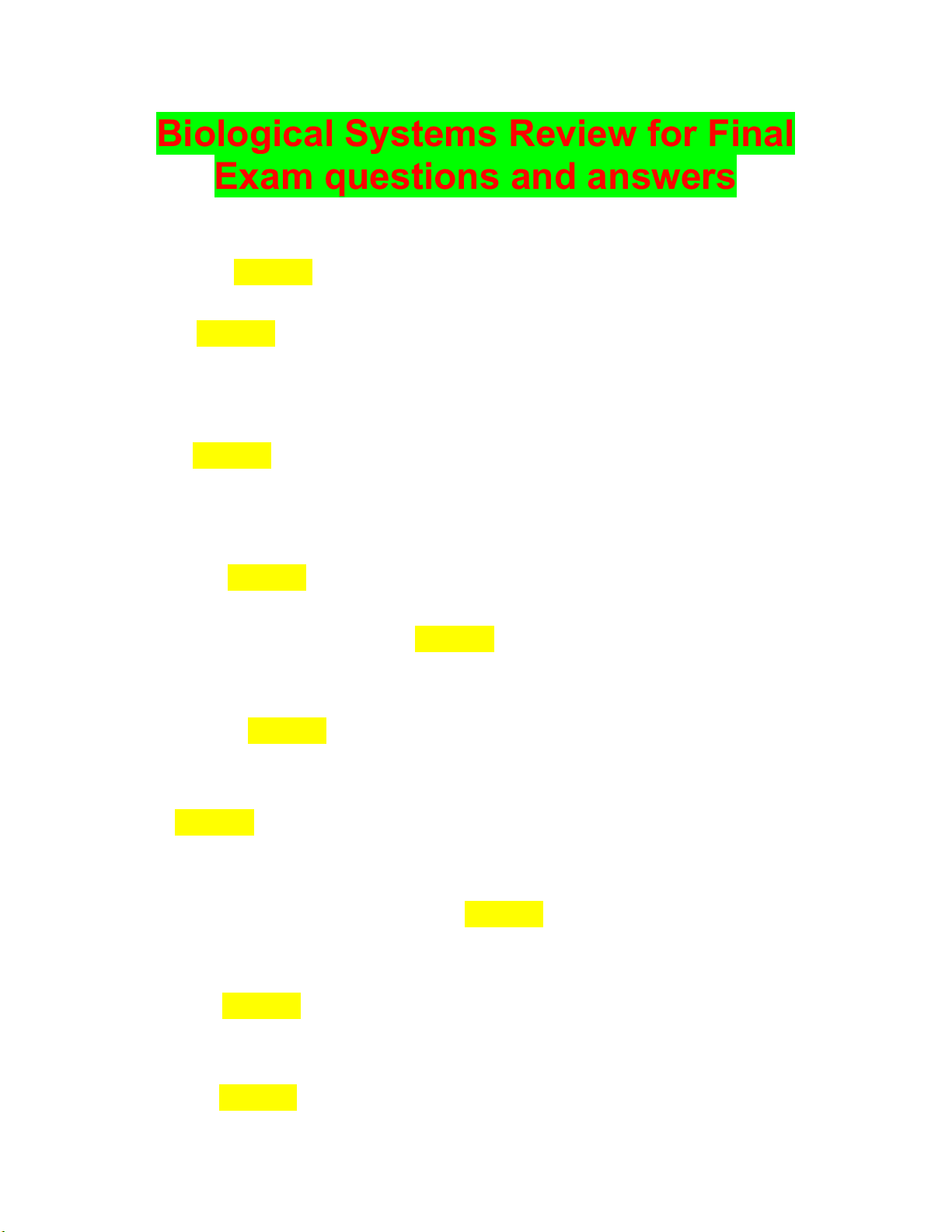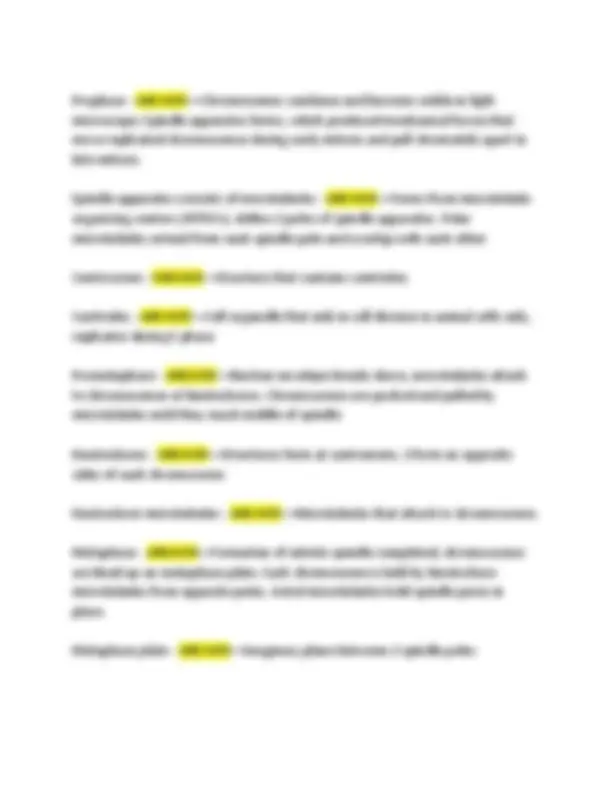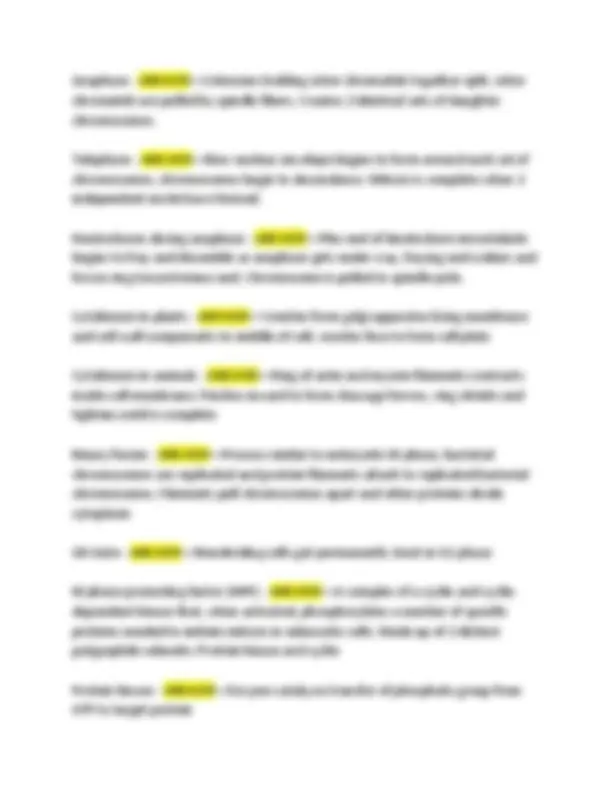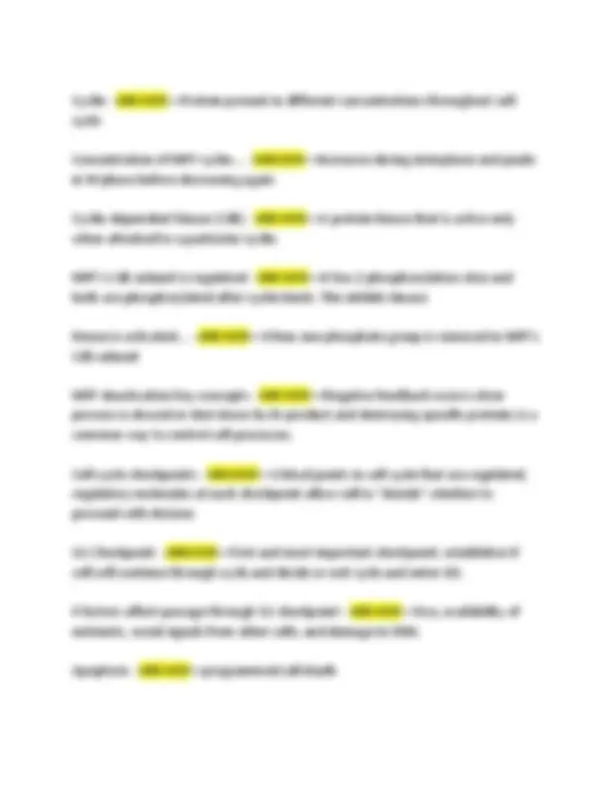





Study with the several resources on Docsity

Earn points by helping other students or get them with a premium plan


Prepare for your exams
Study with the several resources on Docsity

Earn points to download
Earn points by helping other students or get them with a premium plan
Community
Ask the community for help and clear up your study doubts
Discover the best universities in your country according to Docsity users
Free resources
Download our free guides on studying techniques, anxiety management strategies, and thesis advice from Docsity tutors
Biological Systems Review for Final Exam Questions With Revised Answers.
Typology: Exams
1 / 7

This page cannot be seen from the preview
Don't miss anything!




Cell division - ANSWER>>New cells are formed by splitting of pre-existing cells
Meiosis - ANSWER>>Produces reproductive cells called gametes. Produces daughter cells genetically different from each other, have half of the hereditary material as parent cell
Mitosis - ANSWER>>Produces all other cell types--somatic cells. Genetic material is copied and divided equally between two cells, daughter cells are genetically identical to parent cells and to each other
Cytokinesis - ANSWER>>Division into two daughter cells.
Basic steps in cellular replication - ANSWER>>Copying DNA, separating copies, and dividing cytoplasm to create two complete cells
Chromosome - ANSWER>>Single long double helix of DNA wrapped around proteins called histones
Gene - ANSWER>>Region of DNA in chromosome, codes for specific RNA therefore codes for a specific protein
Before mitosis, each chromosome is... - ANSWER>>Replicated. Chromosomes condense into compact structures
Chromatid - ANSWER>>one of two identical "sister" parts of a duplicated chromosome
Cohesions - ANSWER>>Proteins that hold sister chromatids together
Centromere - ANSWER>>Area where the chromatids of a chromosome are attached
M Phase - ANSWER>>Dividing phase of mitotic/meiotic cells. Cells in process of separating their chromosomes
Interphase - ANSWER>>Non-dividing phase, chromosomes are uncoiled. Cells are growing and preparing to divide. Cells spend most time here.
S Phase - ANSWER>>Synthesis phase, stage in which DNA replication occurs.
Cell Cycle - ANSWER>>Orderly sequence of events, occurs from the formation of a eukaryotic cell.
Two gap phases before M Phase - ANSWER>>Single gap between end of M Phase and start of S Phase, and single gap between end of S phase and start of S phase
Cell cycle involves 4 phases - ANSWER>>M Phase, and interphase consisting of G1, S and G
M Phase consists of 2 distinct events - ANSWER>>Mitosis and Cytokinesis
Mitosis in M Phase - ANSWER>>Division of replicated chromosomes, form 2 daughter nuclei with identical chromosome genes
Cytokinesis in M Phase - ANSWER>>Division of cytoplasm, forms 2 daughter cells
Chromatin - ANSWER>>DNA-histone complex, in "relaxed" state during interphase
Mitosis is a continuous process with 5 subphases - ANSWER>>Prophase, prometaphase, metaphase, anaphase, and telophase
Anaphase - ANSWER>>Cohesions holding sister chromatids together split, sister chromatids are pulled by spindle fibers. Creates 2 identical sets of daughter chromosomes.
Telophase - ANSWER>>New nuclear envelope begins to form around each set of chromosomes, chromosomes begin to decondense. Mitosis is complete when 2 independent nuclei have formed.
Kinetochores during anaphase - ANSWER>>Plus end of kinetochore microtubule begins to fray and dissemble as anaphase gets under way, fraying end widens and forces ring toward minus end. Chromosome is pulled to spindle pole.
Cytokinesis in plants - ANSWER>>Vesicles from golgi apparatus bring membrane and cell wall components to middle of cell, vesicles fuse to form cell plate
Cytokinesis in animals - ANSWER>>Ring of actin and myosin filaments contracts inside cell membrane. Pinches inward to form cleavage furrow, ring shrinks and tightens until is complete
Binary fission - ANSWER>>Process similar to eukaryotic M phase, bacterial chromosomes are replicated and protein filaments attach to replicated bacterial chromosomes. Filaments pull chromosomes apart and other proteins divide cytoplasm
G0 state - ANSWER>>Nondividing cells get permanently stuck in G1 phase
M phase-promoting factor (MPF) - ANSWER>>A complex of a cyclin and cyclin- dependent kinase that, when activated, phosphorylates a number of specific proteins needed to initiate mitosis in eukaryotic cells. Made up of 2 distinct polypeptide subunits: Protein kinase and cyclin
Protein kinase - ANSWER>>Enzyme catalyzes transfer of phosphate group from ATP to target protein
Cyclin - ANSWER>>Protein present in different concentrations throughout cell cycle
Concentration of MPF cyclin... - ANSWER>>Increases during interphase and peaks in M phase before decreasing again
Cyclin-dependent kinase (Cdk) - ANSWER>>A protein kinase that is active only when attached to a particular cyclin.
MPF's Cdk subunit is regulated - ANSWER>>It has 2 phosphorylation sites and both are phosphorylated after cyclin binds. This inhibits kinase
Kinase is activated... - ANSWER>>When one phosphate group is removed in MPF's Cdk subunit
MFP deactivation key concepts - ANSWER>>Negative feedback occurs when process is slowed or shut down by its product and destroying specific proteins is a common way to control cell processes.
Cell-cycle checkpoints - ANSWER>>Critical points in cell cycle that are regulated, regulatory molecules at each checkpoint allow cell to "decide" whether to proceed with division
G1 Checkpoint - ANSWER>>First and most important checkpoint, establishes if cell will continue through cycle and divide or exit cycle and enter G0.
4 factors affect passage through G1 checkpoint - ANSWER>>Size, availability of nutrients, social signals from other cells, and damage to DNA
Apoptosis - ANSWER>>programmed cell death
Growth factors - ANSWER>>Small proteins that stimulate division, cells in culture will not grow unless serum is added. Allow cells to pass G1 checkpoint
Key regulatory proteins - ANSWER>>E2F Protein and Rb Protein
E2F protein - ANSWER>>Triggers expression of genes required for S phase. Produced and then blocked by tumor suppressor protein Rb
Rb Protein - ANSWER>>Gatekeeper for G1 checkpoint. Rb binds to E2F and switches E2F "off". Keeps cell in G